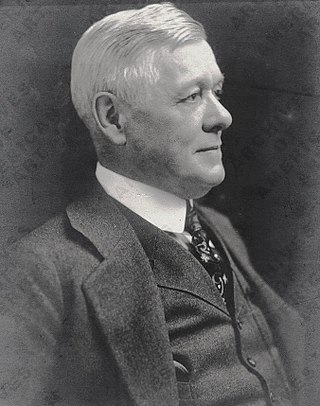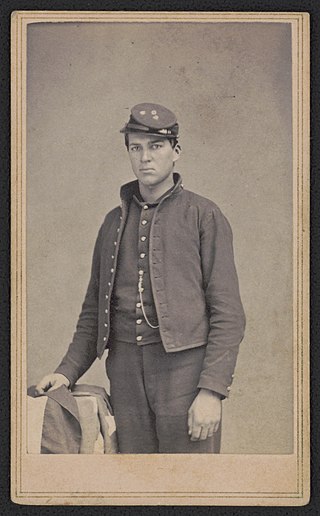
Edward Clark Potter was an American sculptor best known for his equestrian and animal statues. His most famous works are the marble lions, nicknamed Patience and Fortitude, in front of the New York Public Library Main Branch

Frederick William Sievers was an American sculptor, born in Fort Wayne, Indiana. Sievers moved to Richmond, Virginia, as a young man, furthering his art studies by attending the Royal Academy of Fine Arts in Rome, where he studied under Ettore Ferrari and the Académie Julian in Paris. In 1910 when Sievers was commissioned to create the Virginia Monument at Gettysburg, Pennsylvania, he opened a studio in Richmond.

Chickamauga and Chattanooga National Military Park, located in northern Georgia and southeastern Tennessee, preserves the sites of two major battles of the American Civil War: the Battle of Chickamauga and the Siege of Chattanooga. A detailed history of the park's development was provided by the National Park Service in 1998.

George Jerrison Stannard was a Vermont farmer, teacher, governmental official and Union general in the American Civil War.

Caspar Buberl was an American sculptor. He is best known for his Civil War monuments, for the terra cotta relief panels on the Garfield Memorial in Cleveland, Ohio, and for the 1,200-foot (370 m)-long frieze on the Pension Building in Washington, D.C.

James Edward Kelly was an American sculptor and illustrator who specialized in depicting people and events of American wars, particularly the American Civil War.
The 10th Georgia Infantry Regiment was an infantry regiment that served in the Confederate States Army during the American Civil War. It participated in most of the key battles of Robert E. Lee's Army of Northern Virginia.

Roland Hinton Perry was an American sculptor and painter.

John Massey Rhind was a Scottish-American sculptor. Among Rhind's better known works is the marble statue of Dr. Crawford W. Long located in the National Statuary Hall Collection in Washington D.C. (1926).

The 18th Independent Battery Indiana Light Artillery, also known as Lilly's Hoosier Battery and Lilly's Battery, was a civil war regiment formed in Indiana during the American Civil War. The regiment was formed at the end of 1860 by 22-year-old Eli Lilly, an Indianapolis pharmacist. He had recruitment posters placed around the city and recruited primarily among his friends and classmates. The unit contained six 10-pounder Parrott rifles, and was manned by 150 men. The unit mustered in Indianapolis where it was drilled during 1861. Lilly was elected captain of the unit in August 1862 when the unit was deployed to join the Lightning Brigade commanded by Col. John T. Wilder.

Jakob Otto Schweizer was a Swiss-American sculptor noted for his work on war memorials.
Charles Daniel Saalmann was a captain of Union infantry during the American Civil War. He was wounded at Gettysburg and acted as a Commissary of Subsistence during General William T. Sherman's famed March to the Sea. After the war, he established the Black Rose Vineyard near Egg Harbor City, New Jersey. As a vintner, he produced claret wines that received medals at international competitions.
The 75th Regiment Pennsylvania Volunteer Infantry was a unit of the Union Army during the American Civil War. It was composed almost entirely of German-speaking residents of Philadelphia and newly arrived German immigrants. Total enrollment, over the course of the war, was 1,293 officers and men. The 75th Pennsylvania participated in several major battles including Second Bull Run, Chancellorsville, and Gettysburg. The regiment was transferred to the Western Theater in September, 1863. There, it participated in operations in Tennessee, before it was mustered out of service on September 1, 1865, following the close of the war.
The American Civil War bibliography comprises books that deal in large part with the American Civil War. There are over 60,000 books on the war, with more appearing each month. There is no complete bibliography to the war; the largest guide to books is over 40 years old and lists over 6,000 titles.
The Civil War Trust's Civil War Discovery Trail is a heritage tourism program that links more than 600 U.S. Civil War sites in more than 30 states. The program is one of the White House Millennium Council's sixteen flagship National Millennium Trails. Sites on the trail include battlefields, museums, historic sites, forts and cemeteries.

Edward Ludwig Albert Pausch was a Danish-American sculptor noted for his war memorials.

The 147th Pennsylvania Volunteer Infantry was an infantry regiment that served in the Union Army during the American Civil War.

The 2nd New York Cavalry Regiment, officially known as the 2nd Regiment, New York Volunteer Cavalry, was a unit of the Union Army during the American Civil War. It served with the Army of the Potomac and fought in Stoneman's 1863 raid, the Wilson–Kautz Raid, and the Battle of Appomattox Station.













